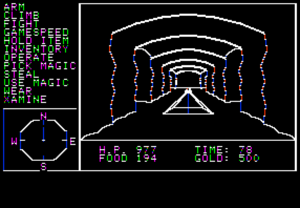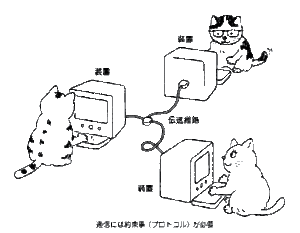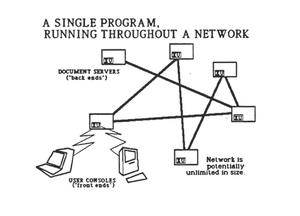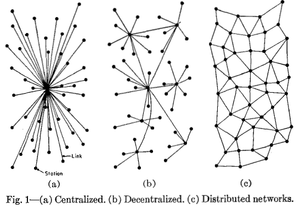Hypermush: Difference between revisions
No edit summary |
No edit summary |
||
| Line 11: | Line 11: | ||
[[File:Mud.png|thumb]] | [[File:Mud.png|thumb]] | ||
''hypermush'' was | ''hypermush'' was a workshop that introduced p2p technologies and their user-applications when disguised as a [https://en.m.wikipedia.org/wiki/MUSH multi-user-shared-hallucination] (MUSH) videogame. | ||
MUSH’s are an evolution of [https://en.m.wikipedia.org/wiki/MUD MUD] (multi-user-dungeon) which are early multiplayer text-based adventure videogames from the 1970s. | |||
We used the MUSH game dynamics to explore the p2p [https://datproject.org/ dat protocol] protocol, and build shared and interconnected narratives by way of dungeon explorations, user group formation, file tradings and key discovery, until it got hyperreal… | |||
Following the slides used during the workshop, and adapted as loose notes to give an introduction to the workshop themes. | |||
[[File:P2p-cats.gif|thumb]] | [[File:P2p-cats.gif|thumb]] | ||
Revision as of 13:34, 23 December 2020
| Hypermush | |
|---|---|
| Name | hypermush |
| Location | De Bonte Zwaan |
| Date | 2018/07/27 |
| Time | 10:00-17:00 |
| PeopleOrganisations | André Fincato, Marcel Goethals |
| Type | HDSA2018 |
| Web | Yes |
| No | |
hypermush was a workshop that introduced p2p technologies and their user-applications when disguised as a multi-user-shared-hallucination (MUSH) videogame.
MUSH’s are an evolution of MUD (multi-user-dungeon) which are early multiplayer text-based adventure videogames from the 1970s. We used the MUSH game dynamics to explore the p2p dat protocol protocol, and build shared and interconnected narratives by way of dungeon explorations, user group formation, file tradings and key discovery, until it got hyperreal…
Following the slides used during the workshop, and adapted as loose notes to give an introduction to the workshop themes.
What is the difference between http(s) and p2p?
- http → you visit locations that serve files (eg you visit the url of a page and that page spits back the content [= files] contained in that page)
- p2p → you visit files directly
- http impose (and needs) a server / client architecture, eg some computers dispense informations, others can consume those informations when going to the right location
- p2p turns any computer into a node of the network:
◦ you can just simply connect with other computers (publish and share stuff, working on same files, broadcasting, etc);
◦ you are using your own computation power instead of using dedicated computers acting as servers;
- http you upload your data onto a server (encryption on? secure connection?)
- p2p by default stores your data onto your device, fully encrypted (eg. dat)
→ p2p makes a good alternative to most silicon-valley applications.
Why not a decentralised + small distributed nodes model, rather than always a planetary synchronised ledger aka blockchain?
schedule and practical information
- 10:00-11:00 introduction to p2p, why we like them, what we do
- 11:00-11:15 break
- 11:15-12:15 setup of the dat software (dat cli, hypermush.app) on people's laptop
- 12:15:13:00 quick introduction / setup of the raspberry pies with the dat software
- 13:00-14:00 lunch
- 14:00:14:30 group formation, characters formation
- 14:30-15:00 dungeon design
- 15:00-15:15 break
- 15:15-17:00 start of the MUSH
People needed to bring their laptop. moreover, it was suggested to make use of the outcomes of the previous days (files, ideas, etc) to inform the design of the dungeon and the general gameplay of the MUSH.







